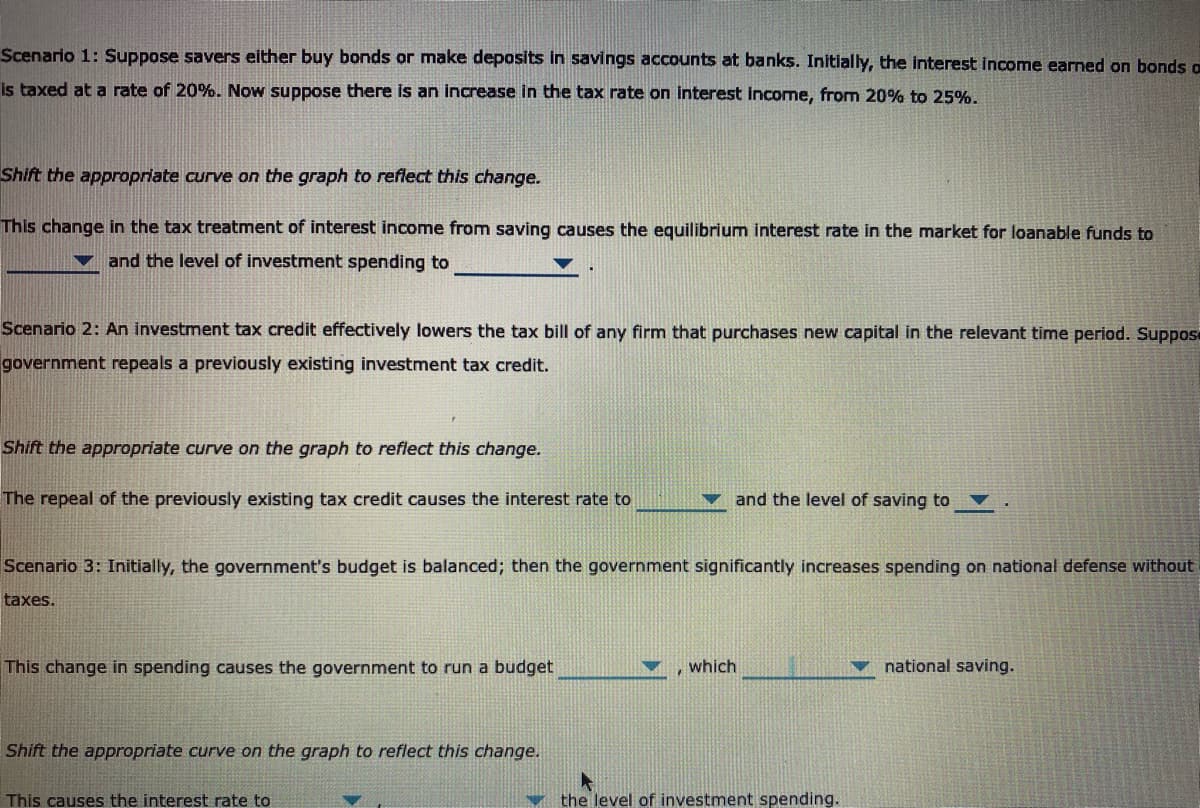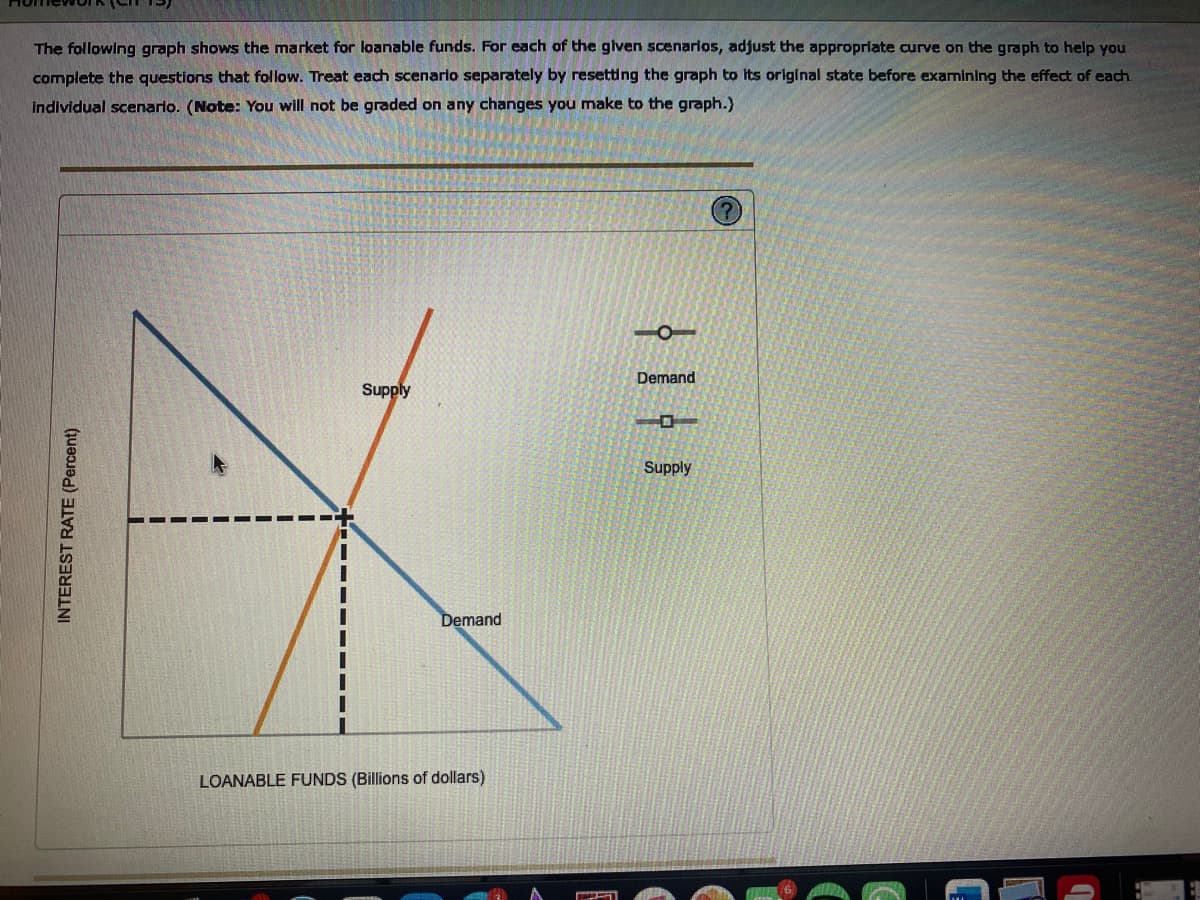Scenario 1: Suppose savers either buy bonds or make deposits in savings accounts at banks. Initially, the interest Income earned on bonds o is taxed at a rate of 20%. Now suppose there is an increase in the tax rate on interest income, from 20% to 25%. Shift the appropriate curve on the graph to reflect this change. This change in the tax treatment of interest income from saving causes the equilibrium interest rate in the market for loanable funds to v and the level of investment spending to Scenario 2: An investment tax credit effectively lowers the tax bill of any firm that purchases new capital in the relevant time period. Suppos government repeals a previously existing investment tax credit. Shift the appropriate curve on the graph to reflect this change. The repeal of the previously existing tax credit causes the interest rate to ▼ and the level of saving to Scenario 3: Initially, the government's budget is balanced; then the government significantly increases spending on national defense without taxes. This change in spending causes the government to run a budget which v national saving. Shift the appropriate curve on the graph to reflect this change. This causes the interest rate to v the level of investment spending.
Scenario 1: Suppose savers either buy bonds or make deposits in savings accounts at banks. Initially, the interest Income earned on bonds o is taxed at a rate of 20%. Now suppose there is an increase in the tax rate on interest income, from 20% to 25%. Shift the appropriate curve on the graph to reflect this change. This change in the tax treatment of interest income from saving causes the equilibrium interest rate in the market for loanable funds to v and the level of investment spending to Scenario 2: An investment tax credit effectively lowers the tax bill of any firm that purchases new capital in the relevant time period. Suppos government repeals a previously existing investment tax credit. Shift the appropriate curve on the graph to reflect this change. The repeal of the previously existing tax credit causes the interest rate to ▼ and the level of saving to Scenario 3: Initially, the government's budget is balanced; then the government significantly increases spending on national defense without taxes. This change in spending causes the government to run a budget which v national saving. Shift the appropriate curve on the graph to reflect this change. This causes the interest rate to v the level of investment spending.
Chapter21: Financial Markets, Saving, And Investment
Section: Chapter Questions
Problem 6P
Related questions
Question

Transcribed Image Text:Scenario 1: Suppose savers either buy bonds or make deposits in savings accounts at banks. Initially, the interest Income earned on bonds o
is taxed at a rate of 20%. Now suppose there is an increase in the tax rate on interest income, from 20% to 25%.
Shift the appropriate curve on the graph to reflect this change.
This change in the tax treatment of interest income from saving causes the eguilibrium interest rate in the market for loanable funds to
v and the level of investment spending to
Scenario 2: An investment tax credit effectively lowers the tax bill of any firm that purchases new capital in the relevant time period. Suppos
government repeals a previously existing investment tax credit.
Shift the appropriate curve on the graph to reflect this change.
The repeal of the previously existing tax credit causes the interest rate to
▼ and the level of saving to
Scenario 3: Initially, the government's budget is balanced; then the government significantly increases spending on national defense without
taxes.
This change in spending causes the government to run a budget
which
v national saving.
Shift the appropriate curve on the graph to reflect this change.
This causes the interest rate to
v the level of investment spending.

Transcribed Image Text:The following graph shows the market for loanable funds. For each of the glven scenarios, adjust the appropriate curve on the graph to help you
complete the questions that follow. Treat each scenario separately by resetting the graph to its original state before examining the effect of each.
individual scenarlo. (Note: You will not be graded on any changes you make to the graph.)
Demand
Supply
Supply
Demand
LOANABLE FUNDS (Billions of dollars)
INTEREST RATE (Percent)
Expert Solution
This question has been solved!
Explore an expertly crafted, step-by-step solution for a thorough understanding of key concepts.
This is a popular solution!
Trending now
This is a popular solution!
Step by step
Solved in 2 steps with 1 images

Knowledge Booster
Learn more about
Need a deep-dive on the concept behind this application? Look no further. Learn more about this topic, economics and related others by exploring similar questions and additional content below.Recommended textbooks for you

Exploring Economics
Economics
ISBN:
9781544336329
Author:
Robert L. Sexton
Publisher:
SAGE Publications, Inc

Exploring Economics
Economics
ISBN:
9781544336329
Author:
Robert L. Sexton
Publisher:
SAGE Publications, Inc